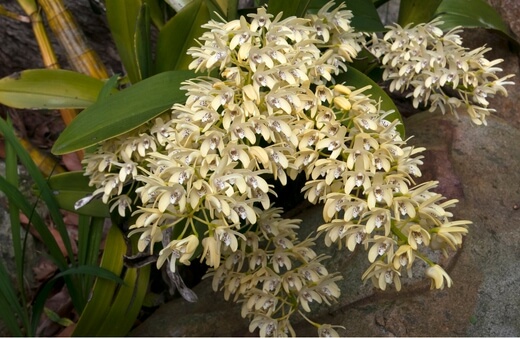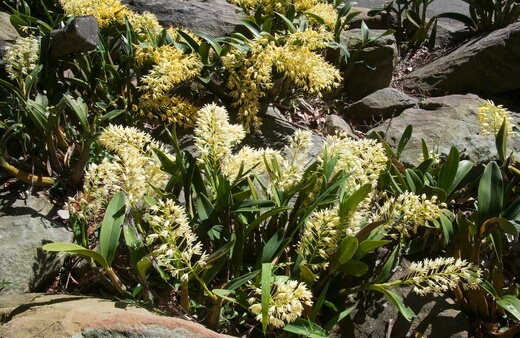When I think of orchids, as much as I love them and their beauty, I also think about how delicate and fragile they generally are. When I first started out gardening, I wouldn’t even dream of investing in an orchid until I discovered a native and hardy kind of orchid, like the Dendrobium speciosum.
In our how to grow and care guide, we’ll look at an introduction to Dendrobium speciosum and its varieties. Learn how to propagate your own plant, how to care for it, and what pests and diseases to look out for.
More...

Family: | Orchidaceae |
|---|---|
Genus: | Dendrobium |
Species: | D. speciosum |
Common Names: | Rock orchid, cane orchid, Sydney rock orchid |
Location: | Indoor or outdoor |
Type: | Orchid |
Growth: | Up to 60 cm tall and 90 cm wide |
Sun requirements: | Bright, indirect light |
Foliage Colour: | Green |
Flower Colour: | Cream, yellow, bright white |
Flowering: | Spring |
Fruit: | None |
Maintenance level: | Average |
Poisonous for pets: | No |
Introducing Dendrobium speciosum
This orchid is probably known to you as the rock orchid or the cane orchid. There are many varieties available and they choose as their home, either a tree trunk or branch (epiphyte) or otherwise live in rock crevices (lithophyte).
This plant occurs in abundance on the east coast of Australia and this plant can thrive at sea level and up to an altitude of 900 metres. Unlike other types of orchids that might be more needy, the Dendrobium speciosum grows quite happily with little attention and you’ll have flowers regardless in spring.
The flowers smell divine and have a star shape. The colour palette is cream to yellow on the outside and bright white inside the flower. You’ll also notice little purple marks on the middle petal.
This plant can produce up to 200 flowers at a time. If you think about where this plant grows naturally, it makes sense that this plant has dense roots that form thick carpets across rocks and cliffs. The roots have the ability to spread out well.
Dendrobium speciosum Varieties

D. speciosum var. blackdownense
This variety is generally a lithophyte. It produces whitish to golden yellow flowers. Bloom time is from August to November.
D. speciosum var. boreale
This variety can be epiphytic or lithophytic. The flowers are shaped like stars and the colour varies from white to cream. It produces flowers from July to September. You would find this particular variety distributed further north than the other varieties.
D. speciosum var. capricornicum
This variety is more often known as the Capricorn rock orchid. It is a lithophyte and produces white flowers. The flowering season happens between May and August.
D. speciosum var. carnarvonense
The more common name for this variety is gorge pink rock orchid. The name is appropriate because it grows in gorges close to a stream. The variety produces only a few small flowers that are pale pink. It usually flowers between August and November.
D. speciosum var. curvicaule
This variety goes by the name rainforest rock orchid. It grows near rainforest and produces white or cream-coloured flowers. The blooming season for this variety is from July to September.
D. speciosum var. grandiflorum
You would more commonly know this variety as the golden king orchid. It grows on trees or rocks and produces big flowers that vary between creamy yellow to bright yellow. This variety flowers from August to October.
D. speciosum var. hillii
This variety is commonly known as the pale king orchid. It grows on trees and rocks and produces many flowers that are either white or cream-coloured. The blooming season is from August to October.
D. speciosum var. pedunculatum
This is the dwarf rock orchid. It grows on rocks and produces white or cream-coloured flowers. The blooms appear from July to August.


Get Your Free Guide:
Master Growing Australian Natives eBook
A Must Have Complete Guide for Every Australian Garden
Get Your Free Guide:
Master Growing Australian Natives eBook
A Must Have Complete Guide for Every Australian Garden
D. speciosum var. speciosum
This variety is more commonly known as the Sydney rock orchid or rock lily. It is a lithophyte and produces cream-coloured or pale yellow flowers. This particular variety blooms between August and October.
How to Grow Dendrobium speciosum

The rock orchid is drought tolerant and can be equally at home in a tropical and a more temperate climate. This plant grows quite compactly and reaches a maximum height of around 60cm.
The plant is pollinated by a type of bee which has no sting and is attracted to its lovely flowers. The leaves of the cane orchid can actually remain on the plant for up to 12 years. They are quite tough and feel like leather.
Propagating Rock Orchid
The easiest way to propagate this orchid is to divide clumps from an existing plant. You can dig up the clump and then divide the crown and the root ball into a few different parts for replanting.
These can then be planted again, either in a new pot or on a suitable rock.
Dendrobium speciosum Care Guide
Sunlight Preference
The ultimate lighting for this orchid is bright and indirect light. If you want more flowers, you just keep it in a sunny spot for a longer period of time. Be sure not to let your plant stand in the midday sun in the hotter months.
For the autumn and winter months, the plant will do alright with direct sunlight. Our advice for the best flower effect is to put your rock orchid somewhere with partial shade and let it get around 3 hours of direct sun in the morning and evening.
Watering Schedule
A guideline for watering is to feel the potting mixture and if it feels dry, water it. You should be guided by the size of the pot, and also your region’s climate. If your cane orchid is in a small pot it will need water more often than a bigger one.
As a guideline, in summertime you can water your plant every 2 days. It’s also advisable to mist them if you live in a dry area so you keep good moisture levels. When winter comes around, you can water every one to two weeks.

Best Soil to Use
A great growing mixture for Dendrobium speciosum is something like bark and perlite. You can also opt for a coarse orchid growing mixture and then you can add your own perlite or charcoal to increase drainage and air flow.
If the plant is still young, you can use fine bark to start off with and then change it to a coarse kind as they grow. Your rock orchid won’t be able to grow in normal garden soil as it can’t handle the moisture levels and this type of soil doesn’t get enough air flow.
Temperature
This plant can handle some crazy temperatures ranging from frost to intense heat. This being said, it’s wise to try and give your plant warmth when it’s actively growing and if frost is an issue, then try and limit exposure.
Wind and frost for long periods of time can cause major setbacks to the plant.
Humidity
This plant likes low to medium humidity and you should balance this with good airflow. Ensure that the pot you are using has draining holes to assist with this. When humidity is too high and there isn’t enough air circulation you will end up with root rot.
Fertiliser
Our advice is to fertilise your cane orchid during spring and summer. This helps to care for the plant’s health and also ensures new growth. You can use a diluted orchid fertiliser and apply every one to two weeks.
You don’t need to fertilise in winter as this plant becomes dormant.
Common Cane Orchid Pests and Diseases
Fungal Disease
Your plant might fall prey to fungal disease. This can be avoided if you make sure not to overwater your plant and manage humidity levels. If your plant does end up with fungal growth, you can use an appropriate fungicide to help treat and manage it.
Dendrobium Beetle
This type of beetle is an absolute nemesis for orchids and very destructive. They cause damage to every part of the plant including the leaves, stems and flowers.
The beetle operates by laying eggs on new plant growth and on the flowers of the Dendrobium speciosum. They are the peskiest during the summer months and can cause major setbacks to any new plant growth.
If your cane orchid has a heavy infestation you’ll need to use an insecticide for treatment. For lighter and more manageable situations, you can pick off the beetles at night and use soapy water to clean off the leaves.
Dendrobium speciosum Frequently Asked Questions

Where did Dendrobium speciosum get its name from?
Speciosum is a Latin word that means beautiful or splendid and certainly seems appropriate.
What happens if the Dendrobium speciosum gets too little or too much light?
This plant likes morning and evening sun. If the sunlight is too much, the leaves will burn and if it doesn’t get enough light, it won’t flower.
What is the ideal kind of potting mix for Dendrobium speciosum?
A mixture of pine bark and perlite is ideal as it’s coarse and well-draining.
Is there a preferred humidity level for the Dendrobium speciosum?
If you want to achieve the best growth for your rock orchid, aim for a humidity level around 50 percent.
What is the best way to prevent Dendrobium speciosum from getting root rot?
The best way to achieve this and one of the most important things for the cane orchid is to make sure there is enough ventilation in the soil. This helps to prevent plant decay.
When should I repot my Dendrobium speciosum
If you start to notice that your soil mixture is starting to decompose, it would then be best to repot your rock orchid. If unsure, aim for spring time.
For more info about orchids and all things gardening, sign up for our newsletter.
Wrapping Up Our Dendrobium speciosum Growing and Care Guide
The rock orchid is an awesome choice for anyone just starting out with gardening. We love a plant that is tough and knows how to handle conditions that are not ideal.
If you are wanting to invest in an orchid that will bring vibrant colour and delightful fragrance to your garden, without the stress of keeping it alive, the Dendrobium speciosum is a wonderful choice.
Published on January 10, 2023 by Lorri Hopkins
Last Updated on January 21, 2025




